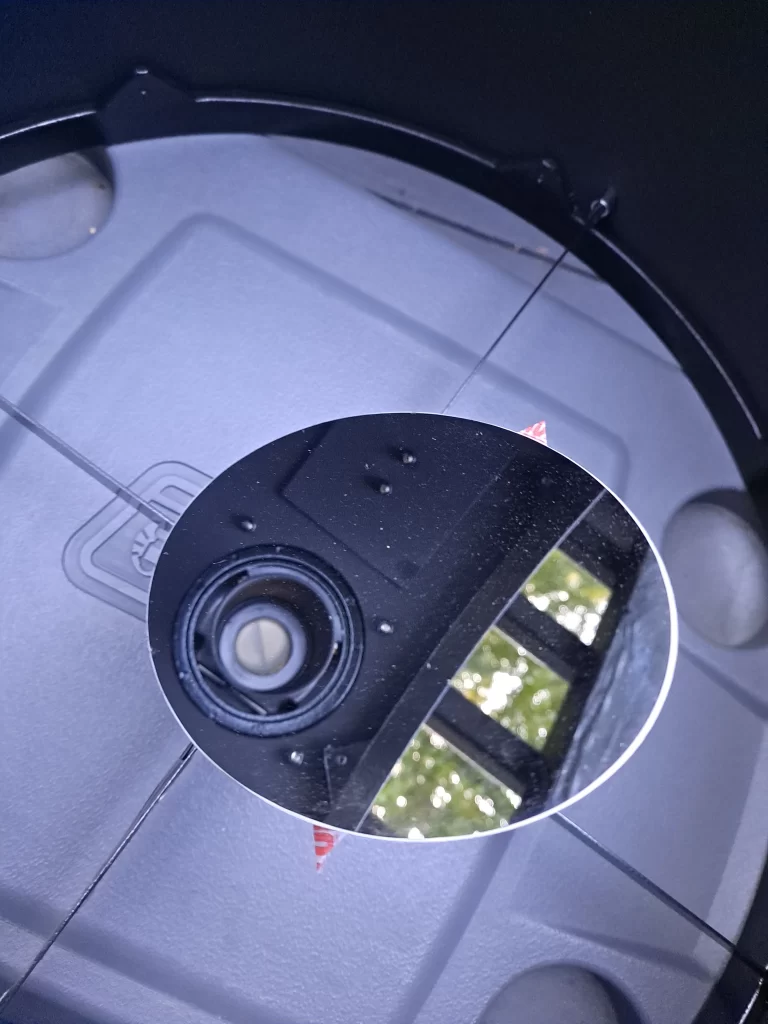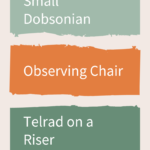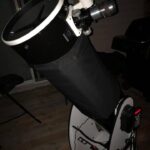Telescope mirrors are curved glass surfaces coated on top with a reflective substance made of aluminum or silver. Each telescope contains 2 or more mirrors. Telescope mirrors can be spherical or parabolic in shape and they can vary in size from very small to enormous. Very large telescopes may even use liquid mirrors.
While glass mirrors are by far the most common, a low cost alternative are liquid mirrors.
Liquid telescope mirrors use a shallow dish or a reflective low melting point metal, usually mercury, which slowly rotates to keep the metal’s surface smooth. This rotation causes the metal to form a slight curve that focuses the light.
The largest liquid mirror telescope was the Large Zenith Telescope in Canada. You can read more about this telescope and see some impressive images of the 6 meter wide mirror.
Why do telescopes use mirrors?
Telescope mirrors are slightly curved glass coated with a reflective material on the surface.
There are two main types of telescopes, reflecting telescopes and refracting telescopes.
Refracting telescopes do not use mirrors. (Some refractors use mirrors in the diagonal, you can read about diagonals in the linked post.)
Reflecting telescopes use mirrors to collect and focus light. That means they use mirrors to make stars, planets and dim distant objects in space.
Reflector telescopes use a primary and a secondary mirror to collect and focus light to the eyepiece. The primary mirror is almost always larger and located at the back of the telescope and the secondary mirror will be tilted or off-axis to direct the light (or image) to the eyepiece.

What type of mirror is used in a telescope?
The type of mirror used in a telescope is a spherical or parabolic shaped glass surface coated with a reflective substance, usually metal. The shape of the mirror allows it to reflect light in a precise way. Refractor type telescopes use glass lenses instead of mirrors to reflect light.
Telescope mirrors differ from household mirrors in their shape and their design. Telescope mirrors are slightly curved to direct the light from a large area to a small eyepiece. These mirrors are ground to a perfect, precise curve so that they will be able to collect and direct the light exactly as needed to be useful.
The reflective coating is also on the surface of the glass as opposed to being behind the glass like a household mirror. This lets the mirror reflect more light, but it does leave the surface vulnerable to damage from dust and dirt in the air.
The coatings on telescope mirrors need to be cleaned and even replaced regularly. Cleaning telescope mirrors is a highly debated topic among astronomers, you can find my controversial opinion on when and how to clean telescope mirrors in the linked post.
What are telescope mirrors made of?
Telescope mirrors are usually a large piece of glass that has been ground to a precise curve. The curved glass is then coated with a reflective coating.
The coating is applied to the curved surface of the mirror. This differs from household mirrors where the reflective surface is on the back and is protected by the glass. On telescope mirrors the coating is on top of the glass so it is vulnerable to damage.
If the reflective surface of a mirror is damaged, it can be ground off and resurfaces very affordably in most cases.
Aluminum
The most common and most popular telescope mirror coating is aluminum. The glass is smoothed out and a thin layer of aluminum is applied to the mirror and polished.
This is often done in a vacuum chamber to ensure a perfectly adhered coating.
There are some enthusiasts that even DIY refinishing their telescope mirrors and there are kits available if you are refurbishing an older telescope or wish to repair a damaged coating.
Aluminum is the cheapest metal used to coat telescope mirrors and the newer enhanced aluminum mirror coatings are fairly durable and low maintenance.
Silver
Silver is another type of metal that can be used to coat glass telescope mirrors.
Gemini Telescopes are well known for using silver in their telescope mirror coatings. Silver is more reflective than aluminum.
Silver does tarnish when it is exposed to sulfur in the air. Tarnish does reduce the light reflecting abilities of the telescope. So, mirrors coated with a silver reflective surface will need frequent polishing.
Gold
Mirrors may be coated in gold as the reflective surface.
The James Webb Space Telescope used gold to coat the mirrors. This decision was made because it resists corrosion better than the above materials and it reflects red and infrared light better than silver or aluminum.
Gold makes seeing infrared easier, there were some things that Hubble could not see because of its limitations in seeing on the infrared light spectrum. Seeing in infrared allows the telescope to see through dust clouds in space.
NASA published this article explaining more thoroughly the decision to use Gold as the reflective material for James Webb.
Gold coated mirrors are available to use in your telescope, but they are very expensive. To replace the mirror in my XX16G, it would be more than $8,000.
Telescope Mirror Shapes
So, we have talked a bunch about how telescope mirrors are curved. This is done very precisely so that the light they direct from the primary mirror will all hit the smaller secondary mirror.
Telescopes are curved into two main shapes, a parabola-type shape called a paraboloid or a spherical shape. It is a bit trickier to manufacture a paraboloid than a spherical mirror, so many telescope mirrors are of the spherical type. There is only a slight difference in performance.
Imagine the liquid type of telescope mirrors, they are shallow dishes of a low melting point metal, usually mercury, they are put in a shallow tray and rotated slowly. Think of a dish of water being spun, the edges would raise slightly and the center would lower slightly.
This shallow bowl shape is necessary for telescope mirrors.
This diagram shows in a simplified and exaggerated way the path of the light from the primary mirror to the secondary mirror.

The curve also changes the size of the objects. Much of the magnification takes place at the eyepiece of a telescope, but the mirrors also provide some degree of magnification on their own. Magnification takes place at every step of the process with a telescope.
You can think of the mirror like a reflective bowl.
The benefit of mirrors over lenses in telescopes is the larger aperture at a lower cost.
Aperture is the measure of the amount of light that a telescope can gather. Larger aperture means that you will be able to see distant dim objects. So reflector telescopes, that use mirrors to collect light, can be produced more cheaply than lenses per inch.
When you are considering a telescope, I think you should get a reflector, because high quality mirrors can be made larger for less money. They are great telescopes for beginners. I think everyone should get a reflector telescope. I know that is a bold statement, but I have my reasons.





